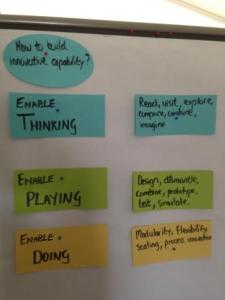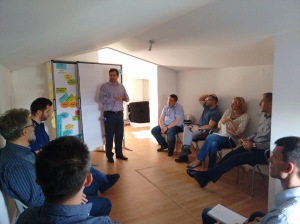When innovation centers, technology transfer centers, applied research platforms and other similar organisations want to help industry with innovation, one way could be to assist companies to experiment with new ideas. I will simply refer to these centers from here onward as innovation and technology support centers. In most of the places where I work these centers are often hosted by or associated with universities, applied research organisations or with technology transfer organisations.
One way to support industry to experiment is through various technology demonstration-like activities, allowing enterprises access to scarce and sophisticated equipment where they can try new ideas. In its simplest form, facilities allow companies to order samples to a certain specification, allowing a company to see whether a particular process can meet a specification or performance criteria. A slightly more intensive form of tech demonstration allows in visitors and a technology and its application is demonstrated (eyes only, no touching!). Very often equipment suppliers play this role, but in many developing countries equipment suppliers behave more like agents and can not really demonstrate equipment.
In Germany I saw demonstration facilities where the pro’s showed the enterprises how things works, and then they stood back allowing teams from a company to try things themselves.
A critical role of innovation support centers is to provide industry with comparative studies of different process equipment. For instance, in an innovation center supporting metal based manufacturers, providing industry with a comparison of the costs and uses of different kinds of CAD systems could be extremely valuable to industry.
Maker labs, Fablabs and similar centers all make it easier for teams that want to create or tinker with an idea to gain access to diverse technologies, reducing the costs of experimenting. However, the range of equipment in these labs are often not so advanced, but it can often be very diversified. In my experience these centers are very helpful to refine early idea formation and prototyping. However, to help manufacturers experiment with different process technologies, different kinds of materials, substitute technologies, etc. is the a binding constraint in many developing countries. The costs of gaining new knowledge is high, and due to high costs of failure, companies do not experiment.
Innovation support centers must be very intentional about reducing the costs of various kinds of experiments if they want manufacturers, emergent enterprises and inventors to try new ideas. These innovation centers can play a role by:
a) assisting companies to internally organize themselves better for experimentation internally
b) assisting many companies to organize themselves better for experimentation collaboratively
c) conducting transparent experiments on behalf of industry collectives
In my experience, graduates from science disciplines often understand how to conduct experiments because their coursework often involve time in a lab. They know basics like isolating variables, managing samples, measuring results, etc. However, engineering graduates often do not have this experience (at least in the countries where I am working most). For many engineering graduates, the closest they will ever get to an experiment is a CAD design, or perhaps a 3D printed prototype.
Therefore, it is necessary for a range of these innovation and technology support centres to assist companies at various hierarchical levels to experiment.
At the functional or operational level, organising for experimentation involves:
- creating teams from different operational backgrounds,
- creating multiple teams working on the same problem,
- getting different teams to pursue different approaches
- failing in parallel and then comparing results regularly
- failing faster by using iterations, physical prototypes and mock ups
- According to Thomke, results should be anticipated and exploited – even before the results are confirmed
At a higher management level, organising for experimentation involves:
- Changing measurement systems to not only reward success, but to encourage trying new things (thus encouraging learning and not discouraging failure).
- moving from expert opinion to allow naivety and creativity
- Preparing for ideas and results that may point to management failures or inefficiencies elsewhere in the firm (e.g. improving a process may be hampered by a company policy from the finance department)
Getting multiple companies and supporting organisations to experiment together is of course a little bit harder. Management of different organisations have many reasons to hide failures, thus undermining collective learning. One way around this could be to use a panel or collective of companies to identify a range of experiments, and then these experiments are conducted at the supporting institution in a transparent way. All the results (success, failures and variable results) are carefully documented and shared with the companies. However, to get the manufacturers to use these new ideas may require some incentives. In my experience, this works much better in a competitive environment, where companies are under pressure to use new ideas to gain an advantage. In industries with poor dynamism and low competition, new ideas are often not leveraged because it simply takes too much effort to be different.
Promising ideas from experiments can be combined and integrated after several iterations to create working prototypes. Here the challenge is to help industries to think small. First get the prototype process to work at a small scale and at lower cost before going to large scale of testing several variables simultanously. An important heuristic is to prototype at as small as possible scale while keeping the key mechanical or scientific properties consistent. More about this in a later post. (Or perhaps some of the people I have helped recently would not mind sharing their experience in the comments?)
I know this is already a long post, but I will add that Dave Snowden promotes Safe2fail probes, where teams are forced to design a range of experiments going in a range of directions even if failure is certain in some instances. In my experience this really works well. It breaks the linear thinking that often dominates the technical and manufacturing industries by acknowledging that while there may be preferred solutions, alternatives and especially naive experiments should be included in the overall portfolio. To make this work it is really important that the teams report back regularly on their learning and results, and that all the teams together decide which solutions worked best within the context.
THOMKE, S.H. 2003. Experimentation Matters: Unlocking the Potential of New Technologies for Innovation. Harvard Business Press.

 the organization. This includes looking at technologies that could affect the clients of the organization, and technologies that could disrupt markets and industries.
the organization. This includes looking at technologies that could affect the clients of the organization, and technologies that could disrupt markets and industries.







